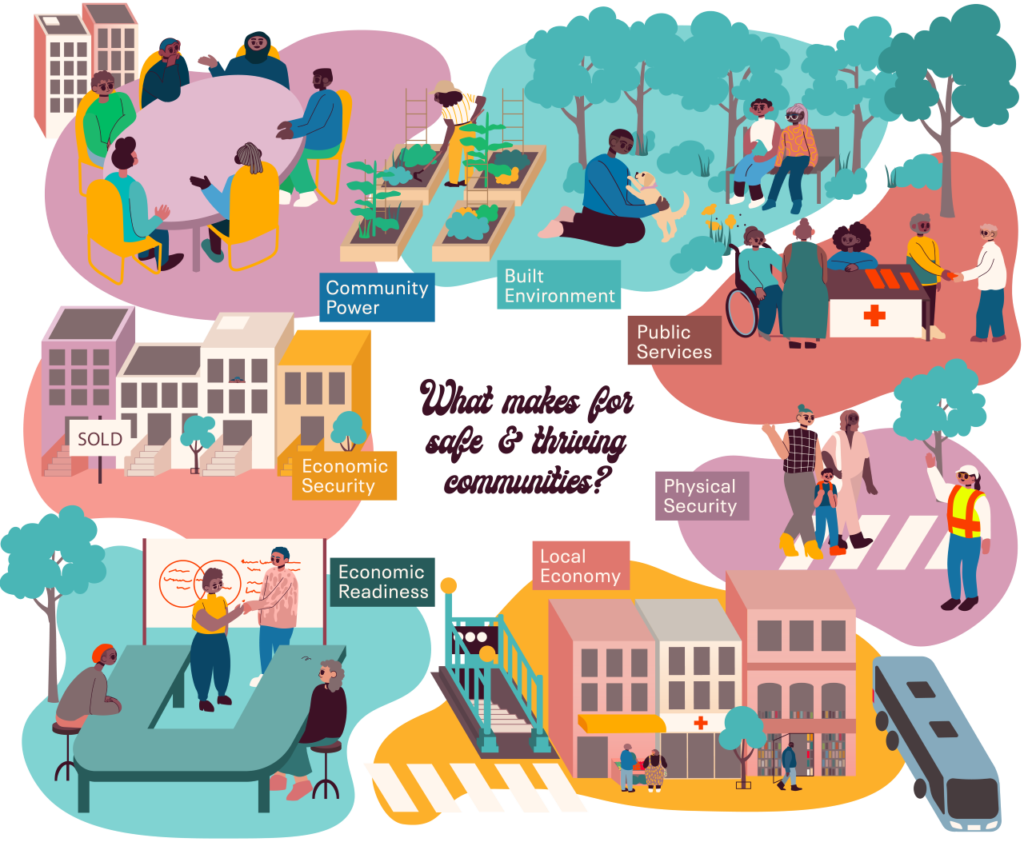ONS Neighborhood Navigator
The NYC Office of Neighborhood Safety (ONS) Neighborhood Navigator was born out of the need to render how the programming and theories of change of the Office of Neighborhood Safety, which centers community and participatory governance in co-producing safety and thriving, is the way we should work with community to build safe and thriving communities across NYC.
In a time where public safety is being redefined, there is little discussion or centering of how historically disinvested black and brown communities define public safety and what contributes to safer communities. The initiative’s first and most important contribution is centering the voices of NYC black and brown communities and elevating the metrics and factors which government should work on with community in order to create safe and thriving communities.
Goal of the Neighborhood Navigator
The NYC Mayor’s Office of Criminal Justice (MOCJ) seeks to develop improved measures of social determinants of health to inform policy and social interventions for criminal justice and community settings, incorporating community-driven research and community engagement. Social determinants are the racial inequities, institutions, policies, and community conditions where we live, work, and play (e.g., access to safe living conditions, stable housing, and quality healthcare, schools and jobs) that are the root causes of poor outcomes in crime, health, and wellbeing. The solution is to invest in human, social, and physical capital to address racial and social inequities seen in New York City.
Future of the Neighborhood Navigator
MOCJ aims to expand the ONS Neighborhood Navigator initiative beyond the pilot to enable ongoing and sustainable community-driven metrics to understand key needs, priorities and power, to inform immediate and critical government responses, and to build government transparency and accountability within and across City Agencies.
Research Approach & Partners
MOCJ worked with several research partners to carry out the task. The NIS community co-produced research framework was employed to organize all the data generated and/or compiled by JohnJayREC, NORC at the University of Chicago, and Columbia University SAFElab. Please review the MOCJ Research Note to understand the research approach, limitations, and concerns.
| Research Partner | Roles & Responsibilities |
| John Jay Research and Evaluation Center (JohnJayREC) | Coordinate research activities across vendors and identify existing social determinants data among public and available administrative data to, consolidate, analyze, and contextualize community conditions and safety in 15 pilot neighborhoods. |
| NORC at the University of Chicago | Measure community perceptions on trust, safety, social service needs, COVID-19 impacts, and key priorities through the design and administration of a 3-wave panel survey in 15 pilot neighborhoods. |
| National Innovation Service (NIS) | Partner with impacted communities to co-create framework and recommended metrics for safety and thriving, as well as developing evaluation framework to evaluate ONS community initiatives. |
| Columbia University SAFElab | Identify emerging Trends and Community Needs around community conditions, safety, and COVID-19 impacts in the 15 pilot neighborhoods |
| Velir | Development of the data visualization tool embedded within the existing MAP website to present data, findings, and new approaches to neighborhood safety data. |
Neighborhood Navigator Team

MOCJ-Research Team
Abdul Nasser Rad
Senior Research Manager
Dr. Josephine Wonsun Hahn
Former Research Director, Racial Equity & Fairness
Dr. Brenda Velazquez
Executive Director of Research Operations
ONS Program Team
Alexius Marcano
Senior Program Operations Manager, MAP
Tara Singh
Deputy Executive Director, MAP
Renita Francois
Executive Director, MAP
What contributes to building safe and thriving communities?

The following indicators are meant to be a reflection of the ways in which the Black and Brown residents we engaged in this participatory research project spoke about community safety and thriving. While the indicators themselves were sourced by NIS, the need for them emerged directly from an analysis of focus group and interview data, which surfaced the conditions underlying community safety and thriving. To read more about the findings and research framework, please see the NIS “Measuring Community Safety in NYC” report.
Economic Security
Economic Readiness
Local Economy
Physical Security
Public Services
Built Environment
Community Power